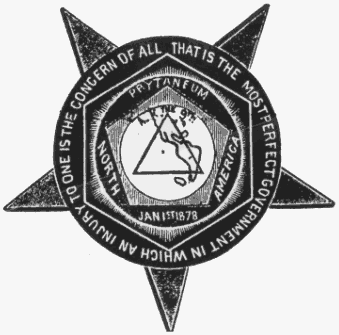
April 1, 2017, by Harry Cocks
The Knights of Labor: New Perspectives
The Noble and Holy Order of the Knights of Labor is a staple of American labour history, Steven Parfitt writes. The Knights began in 1869 in Philadelphia, spread throughout the United States in the next two decades, and became the first truly national working-class movement to appear in that country. In 1886 they boasted nearly a million members. They organised women and black workers on a scale never seen before, and not seen again for some time. After 1886 the Knights slowly fell into decline. Their last leader formally wound up the organisation exactly one hundred years ago, in 1917.
American labour historians have written and rewritten their history ever since. Yet they have seldom addressed one of the most unusual aspects of that history: namely, that the Knights burned with the ambition to extend their Order beyond the United States and Canada, and to make of that Order a global movement with branches in all parts of the world. The Knights made good on that ambition to an extent matched by few other working-class movements in the nineteenth century. Their assemblies, as they called their branches, appeared in England, Wales, Scotland, Ireland, France, Belgium, Italy, Australia, New Zealand and South Africa. Despite this impressive record, historians have been slow to bring the global history of the Knights of Labor in line with its American one.
My recent book, Knights Across the Atlantic, is one attempt to redress this imbalance by providing the first major study of the Knights in Britain and Ireland. The Knights arrived in Britain in 1883, forming a short-lived assembly in Cardiff, before American glassworkers sent organisers across the ocean to form a transatlantic alliance with glassworkers in England, Belgium and other European countries. English glassworkers at all the major centres of window-glass production, Sunderland, Smethwick and St Helens, soon formed their own assembly of the Knights of Labor. Over the course of the 1880s, assemblies of workers in other industries appeared in Birmingham and the Black Country, South Yorkshire, Liverpool, Glasgow, Belfast and Derry. By 1890, as many as 15,000 or even 20,000 British and Irish workers joined the Knights. That growth soon turned to decline. By 1895, virtually all the assemblies had disappeared.
Knights Across the Atlantic does more than simply chart the history of a short-lived and ultimately unsuccessful American movement on British and Irish soil. The British and Irish Knights, I argue, were an important and under-recognised part of two great developments in British labour history. One is the birth of the Labour Party. The other is what historians call the “new unionism,” the great upsurge in strikes and union membership between 1889 and 1891. The Labour Party challenged the old complacent two-party racket and gave a voice to previously voiceless workers. The new unionism sped the transformation of the British trade union movement in the late nineteenth and early twentieth centuries, from a minority movement composed of skilled workers to a majority of wage earners.
The role of the Knights of Labor in either one of these epochal changes would be enough to justify a better understanding of their British and Irish history. But Knights Across the Atlantic addresses other themes as well. I compare the record of British and American Knights when it came to gender and race. I argue that the successes that Knights achieved at home and abroad should make us doubt the common idea that American labour movements have always been backward, at least compared with their European counterparts. I deal with the problems that arise when a movement from one country extends into another. Do you stick with the methods and programme of the home country or adapt them to new conditions? How can you sustain a movement that stretches across vast expanses of land and sea? Knights Across the Atlantic addresses all these questions in some depth.
My book is only one step, if a large one, to a wider goal: the first global history of the Knights of Labor. In five journal articles published over the last few years I have begun to sketch the outlines of what that global history might look like. In the next two years I hope to bring them together in a comprehensive, book-length study. Until then, Knights Across the Atlantic sits alongside Robert Weir’s Knights Down Under: The Knights of Labor in New Zealand, as the only book to be written on the history of the Knights outside North America in the last fifty years.
Knights Across the Atlantic: The Knights of Labor in Britain and Ireland. University of Liverpool Press: 2017.
“Powderly Will Go to Paris: The Paris Exposition and the Knights of Labor,” International Labor and Working-Class History, 2017.
“A Nexus Between Labour Movement and Labour Movement: The Knights of Labor and the Financial Side of Global Labour History,” Labor History, 2017.
“Constructing the Global History of the Knights of Labor,” Labor: Studies in Working-Class History of the Americas, 14:1 (2017), pp. 13-37.
“Writing the History of the Australian Knights of Labor.” Labour History 110 (2016), pp. 1-18.
“The First-and-a-half International: The Knights of Labor and the History of International Labour Organization in the Nineteenth Century,” Labour History Review, 80:2 (2015), pp. 135-67.
No comments yet, fill out a comment to be the first

Leave a Reply